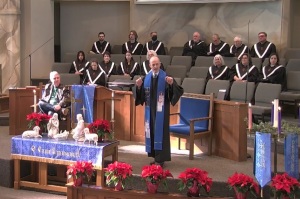Old Wounds Brought to New Light—Dialogue on the Controversial, "Greet God and Hail Hitler"
VIENNA, Austria – Stefan Moritz's book about Austria's pro-Nazi priests, who helped thousands of Hitler's henchmen escape, is raising enormous controversy in the 80 percent catholic Austria. In his book, "Gruess Gott und Heil Hitler" ("Greet God and Hail Hitler"), Mr. Moritz, 36, claims Austria's Roman Catholic Church ignored and even abetted Nazi horrors.
"A woman just screamed 'Heil Hitler,' and hung up," said Mr. Moritz. "Another caller asked me if I were a Jew, because only a Jew could write garbage like this."
Mr. Moritz acknowledges that not all Austrian clergy were cowards or collaborators. He sites the case of the Rev. Franz Reinisch, who was banned from preaching because of his critical stance toward the Nazis. The church, instead of backing Father Reinisch, expelled him from his Pallotine order, and he was executed in 1942 after refusing to swear loyalty to Hitler and join his army, Mr. Moritz writes.
However, the bulk of his book argues that the Austrian church in general, the priests and bishops went beyond silence to actively support the Nazis. His book includes dozens of documents that support his argument. Some of which, came from parish archives, include:
A chillingly dispassionate entry dated Nov. 26, 1942, from the Austrian Bishops' Conference, that skims over the mass deportation of Jews to Nazi death camps by noting that over one year, "33 transports of 1,000 each have gone to Poland." By that time, some bishops were signing off with "Heil Hitler" on official letters and priests were authorized to display the swastika.
Influential Jesuit Mario von Galli describing Jews as "God's murderers" who deserve persecution. In 1940, as Gypsies started joining the Jews on death trains packed to suffocation point, the Vienna archdiocese urged all parishes to do their utmost to "combat the Gypsy chaos" in the Austrian capital by reporting Gypsies to the police.
The parish newspaper "Erdberger Pfarrblatt" urging Catholics to support Hitler by declaring "One people — one Reich — one Fuehrer — one God!"
Rural priest Franz Mandl, in a lectern-thumping speech, calling Hitler "the greatest human being," one of dozens documented praising the Nazi dictator; and an internal church document blaming Jewish politicians and writers for the decline in pure-race Germanic births.
A listing of pro-Hitler Austrian clergy staying in or promoted to leading positions after the war. It included Bishop Alois Hudal, who boasted of helping about 50,000 war crimes suspects to hide or escape. Among them was Franz Stangl, commander of Treblinka concentration camp in Poland where 800,000 Jews were killed. He was arrested in Brazil after two decades on the run with a false passport procured through Bishop Hudal.
After decades of denial, Austria has come a long way in acknowledging the major cooperation of Austrians like Stangl in doing Hitler's most ruthless works. Many government leaders, with the exception of a few far-right politicians, now publicly condemn the country's Nazi past, and pass laws regulating millions of dollars in restitution.
On the religious realm, most of Austria's Gothic cathedrals and onion-domed village churches have resisted scrutiny, with only a few cardinals and bishops speaking forthrightly about the links of some of their predecessors to the Nazi regime.
A similar accusation arose in neighboring Germany. Allegations persist that the Roman Catholic Church failed to speak out against the Nazi Holocaust and to properly acknowledge its silent complicity.
"A Moral Reckoning: The Role of the Catholic Church in the Holocaust and its Unfulfilled Duty of Repair," a new book by American historian Daniel Goldhagen, re-examines the case against the church and has been attacked by critics and church officials as lacking historical foundation.
Last month, the book ran into more controversy as a German court ordered a picture caption blacked out in the German translation. The court was acting on a complaint by the Munich diocese that the caption misidentified a church official at a Nazi event.
Mr. Goldhagen claimed it was "a desperate attempt on the part of the church to try and torpedo this book and avoid a real discussion."
Some influential prelates in Germany, as in the case of Austrian prelates, acknowledge their past. Cardinal Karl Lehmann of Mainz urged the Vatican earlier this year to open its Nazi-era archives for the first time.
Most of Austria's clergy, however, and those still alive with memories of the church's role more than half a century ago, refuse to answer the call, and are either reluctant to talk or plead fading memory.
"Mayer, the principal of our school, he was an 'illegal one,'" said Hermine Reiterer, 83, using the term for the keenest Nazis, who joined Hitler's party in the early 1930s while it was still banned in Austria. "He was extremely active in our church."
Austria's Roman Catholic church spokesman, Erich Leitenberger, similar to the Vatican response, describes the clergy as a victim of the Nazis. Nonetheless, he acknowledges the existence of "misguided Catholics" in the church hierarchy, "who thought their prejudices were confirmed by National Socialism," and the Nazi Ideology.
By Pauline J.
pjang@chtoday.com




























